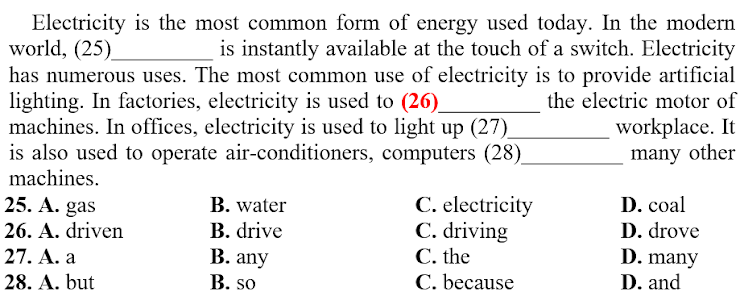Read the following passage and mark the letter A, B, C or D to indicate the correct word or phrase that best fits each of the numbered blanks.
HEALTH DETECTOR
Scientist Hayat Sindi’s device is the sire of a postage stamp, and it costs just a penny. But it could (23) _________ millions of lives. In many parts of the world, doctors and nurses work with no (24) ________ or clean water. They have to send health tests to labs and wait weeks for results. But this little piece of paper could change that. It contains tiny holes that are filled with chemicals. These chemicals are able (25) _______ health problems. A person places a single drop of blood on the paper. The chemicals in the paper change (26) ________ the blood and indicate (27) _______ or not the person has an illness.
23. A. build B. keep C. start D. save
24. A. electric B. electrical C. electrician D. electricity
25. A. detect B. detecting C. to detect D. to detecting
26. A. although B. because C. due to D. in spite of
27. A. as if B. either C. neither D. whether
Read the following passage and mark the letter A, B, C or D to indicate the correct answer to each of the questions.
Mercury is the smallest member of the sun's family. It is only 3.100 miles across. It is also the sun's swiftest planet. Its yearly journey round the sun is only 85 days.
Mercury always keeps one side towards the sun. On this side it is always day, on the other side always night. We only see the lighted side.
Mercury appears to us like a yellowish orange star. The nearest planet to the sun, it is always seen near the sun, either just before sunrise or soon after sunset. People sometimes call mercury the morning star or evening star. Mercury is half the size of the earth. Because it is much lighter, it has much less gravity. If you can visit Mercury in a spaceship, you will find it a strange world. Its low gravity makes you feel very light. If your weight on earth is 100 pounds, your weight on Mercury is only 27 pounds. Looking at the sun from Mercury, you can see that it's much more brilliant than it is seen from the earth. And the yellow centre of the sun appears three times bigger from Mercury. On its lighted side, Mercury's temperature is about 300 degrees centigrade. But the dark side is extremely cold, but 150 degrees below zero so mercury is probably the coldest as well as the hottest of the planets.
28. The word “swiftest” in paragraph 1 is closest in meaning to _______.
A. fastest B. coldest C. hottest D. biggest
29. We cannot see the dark side of Mercury because_______.
A. it moves very fast
B. it always appears just before sunrise or soon after sunset
C. it always keeps one side towards the sun
D. it is too far for us to see
30. When can we see Mercury? - We can see it_______.
A. just before the sunset B. just before sunrise
C. after the sunset D. both A and C are correct
31. Why do we weigh much on the earth than on Mercury? - Because_______.
A. Mercury is nearer to the sun B. Mercury has got less gravity than the earth
C. Mercury is much hotter D. none are correct.
32. Why does the sun look bigger when it is seen from Mercury? - Because_______.
A. Mercury is the smallest planet of the sun
B. Mercury is nearer to the sun
C. Mercury is a light planet
D. It only takes Mercury 88 days to move round the sun.


Đáp án A
Kiến thức về từ vựng
A. convert /kən'vɜ:t/ (v): chuyển đổi
B. alter /'ɒltər/ (v): thay đổi
C. transmit /trænz'mɪt/ (v): truyền tải (tín hiệu, âm thanh)
D. transfer /træns'fɜ:r/ (v): luân chuyển di dời
Căn cứ vào nghĩa của câu: “Undergraduates at Oxford and Cambridge study for a BA degree, but after a period of time graduates can (50)_____ their BA to an MA without doing any further study.” (Các sinh viên đại học tại Oxford và Cambridge học lấy bằng cử nhân, nhưng sau một thời gian sinh viên tốt nghiệp có thể chuyển đổi BA của mình thành MA mà không cần học thêm gì nữa.)